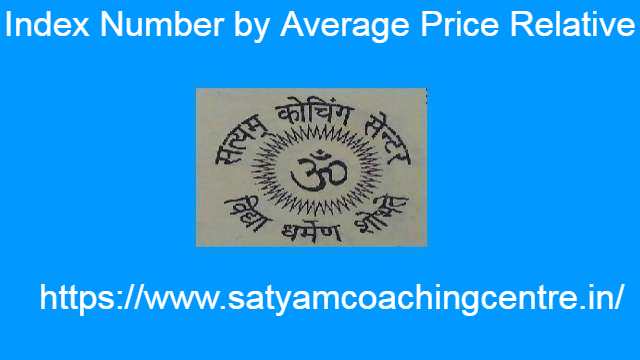Index Number by Average Price Relative
1.औसत मूल्यानुपात द्वारा सूचकांक (Index Number by Average Price Relative),श्रृंखला आधार रीति द्वारा सूचकांक (Index Numbers from Chain Base Method):
औसत मूल्यानुपात द्वारा सूचकांक (Index Number by Average Price Relative) में यदि मूल्य मात्रा के रूप में दिए हों तो उन्हें सर्वप्रथम रुपयों में परिवर्तित करेंगे।मूल्यों का औसत मूल्य ज्ञात करेंगे।अब औसत मूल्य को आधार मानकर प्रत्येक वर्ष के लिए मूल्य सूचकांक की रचना करेंगे।
आपको यह जानकारी रोचक व ज्ञानवर्धक लगे तो अपने मित्रों के साथ इस गणित के आर्टिकल को शेयर करें।यदि आप इस वेबसाइट पर पहली बार आए हैं तो वेबसाइट को फॉलो करें और ईमेल सब्सक्रिप्शन को भी फॉलो करें।जिससे नए आर्टिकल का नोटिफिकेशन आपको मिल सके । यदि आर्टिकल पसन्द आए तो अपने मित्रों के साथ शेयर और लाईक करें जिससे वे भी लाभ उठाए । आपकी कोई समस्या हो या कोई सुझाव देना चाहते हैं तो कमेंट करके बताएं।इस आर्टिकल को पूरा पढ़ें।
Also Read this Article:-Quartile Coefficient of Skewness
2.औसत मूल्यानुपात द्वारा सूचकांक के साधित उदाहरण (Index Number by Average Price Relative Solved Examples):
Example:1.निम्नलिखित सारणी में 2001 से 2004 तक के पाँच वस्तुओं के औसत थोक मूल्य प्रस्तुत हैं।श्रृंखला आधार रीति से सूचकांक की रचना कीजिएः
(Average wholesale price of five articles are given in the following table from the 2001 to 2004.Contruct Index Nos. by chain base method):
Average wholesale price (औसत मूल्य सूचकांक)
| Articles | 2001 | 2002 | 2003 | 2004 |
| A | 30 | 32 | 36 | 40 |
| B | 20 | 22 | 25 | 30 |
| C | 40 | 44 | 46 | 50 |
| D | 45 | 50 | 52 | 55 |
| E | 55 | 60 | 61 | 65 |
Solution:Calculation Table of Chain Base Indices
For 2001 and 2002
| Articles | 2001 | 2002 | ||
| Price | LR | Price | LR | |
| A | 30 | 100 | 32 | 106.67 |
| B | 20 | 100 | 22 | 110 |
| C | 40 | 100 | 44 | 110 |
| D | 45 | 100 | 50 | 111.11 |
| E | 55 | 100 | 60 | 109.09 |
| Total | 500 | 546.87 | ||
| Avg. of LR | 100 | 109.4 | ||
| chain Indices | 100 | \frac{109.4 \times 100}{100} | ||
| chained with 2001 | =109.4 | |||
For A 2003 and 2004
| Articles | 2003 | 2004 | ||
| Price | LR | Price | LR | |
| A | 36 | 112.5 | 40 | 111.11 |
| B | 25 | 113.63 | 30 | 120 |
| C | 46 | 104.54 | 50 | 108.70 |
| D | 52 | 104 | 55 | 105.77 |
| E | 61 | 101.67 | 65 | 106.56 |
| Total | 536.34 | 552.14 | ||
| Avg. of LR | 107.3 | 110.4 | ||
| chain Indices | \frac{107.3 \times 109.4}{100} | \frac{110.4 \times 117.4}{100} | ||
| chained with 2001 | 117.4 | 129.6 | ||
Example:2.निम्न समंकों से श्रृंखला आधार रीति द्वारा समान्तर माध्य तथा मध्यका का प्रयोग करते हुए सूचकांक ज्ञात कीजिएः
(Calculate Index Numbers from Chain Base method from the following data using arithmetic mean and median.)
| Items | 1997 | 1998 | 1999 | 2000 |
| A | 75 | 80 | 60 | 55 |
| B | 80 | 60 | 55 | 50 |
| C | 70 | 80 | 65 | 55 |
| D | 65 | 75 | 60 | 50 |
| E | 34 | 30 | 28 | 25 |
Solution:Calculation Table of Chain Base Index Numbers
| Price INR | ||||
| Items | 1997 | 1998 | 1999 | 2000 |
| A | 75 | 80 | 60 | 55 |
| B | 80 | 60 | 55 | 50 |
| C | 70 | 80 | 65 | 55 |
| D | 65 | 75 | 60 | 50 |
| E | 34 | 30 | 28 | 25 |
| Total of Price Relatives | ||||
| Mean of Price Relatives | ||||
| Median of Price Relatives | ||||
Price Relatives
| Price Relatives | ||||
| Items | 1997 | 1998 | 1999 | 2000 |
| A | 100 | 106.67 | 75 | 91.67 |
| B | 100 | 75 | 91.67 | 90.91 |
| C | 100 | 114.29 | 81.25 | 84.62 |
| D | 100 | 115.38 | 80 | 83.33 |
| E | 100 | 88.24 | 93.33 | 89.29 |
| Total of Price Relatives | 500 | 499.58 | 421.25 | 439.82 |
| Mean of Price Relatives | 100 | 99.92 | 84.25 | 87.96 |
| Median of Price Relatives | 100 | 106.67 | 81.25 | 89.29 |
Example:3.निम्नलिखित समंकों के औसत मूल्यों को आधार मानकर तीन वर्षों के सूचकांकों की रचना कीजिएः
(Prepare index numbers for three years taking average price as base):
| Prices in Rupees | |||
| Year | Wheat | Cotten | Oil |
| 2002 | 125 | 500 | 150 |
| 2003 | 100 | 450 | 125 |
| 2004 | 75 | 490 | 100 |
Solution:Calculation Table of Index Numbers Taking Average Price=100
| Price on Rupees | Total of price | Avg of price | ||||
| Year | Wheat | cotton | Oil | Relatives | Relatives | |
| 2002 | 125 | 500 | 150 | |||
| 2003 | 100 | 450 | 125 | |||
| 2004 | 75 | 490 | 100 | |||
| Total | 300 | 1440 | 375 | |||
| Average | 100 | 480 | 125 | |||
| Price | 2002 | 125 | 104.17 | 120 | 349.17 | 116.39 |
| Relatives | 2003 | 100 | 93.75 | 100 | 293.75 | 97.92 |
| 2004 | 75 | 102.28 | 80 | 257.08 | 85.69 | |
Example:4.निम्न सूचनाओं से तीन वर्षों के सूचकांक की रचना औसत मूल्य के आधार पर कीजिएः
(From the following information construct index numbers of prices taking average price as the base):
| Rate Per Ten Rupees | |||
| Year | Wheat | Rice | Sugar |
| I | 10 kgms | 2.5 kgms | 5 kgms |
| II | 8 kgms | 2.0 kgms | 5 kgms |
| III | 5 kgms | 1.6 kgms | 2 kgms |
Solution:प्रश्न में मूल्य मात्रा के रूप में व्यक्त हैं जबकि मूल्य रुपयों में व्यक्त किए जाते हैं,अतः सर्वप्रथम मात्रा को रुपयों में परिवर्तित करेंगे।मूल्यों का परिवर्तन प्रति क्विंटल (100 kg) आधार पर करके प्रत्येक वस्तु का औसत मूल्य ज्ञात करेंगे।अब औसत मूल्यों को आधार मानकर प्रत्येक वर्ष के मूल्य सूचकांकों की रचना करेंगे।इस प्रकार Wheat का मूल्य \frac{100}{10} =10,\frac{100}{8}=12.5,\frac{100}{20} रुपए प्रति क्विंटल होंगे।इसी प्रकार Rice तथा Sugar के लिए मूल्य प्रति क्विंटल ज्ञात किए गए हैं।
Calculation Table of Index Numbers Taking Average Price=100
| Price in Rupees | Total of price | Avg of price | ||||
| Year | wheat | cotton | oil | Relatives | Relatives | |
| I | 10 | 40 | 20 | |||
| II | 12.5 | 50 | 20 | |||
| III | 20 | 62.5 | 50 | |||
| 42.5 | 152.5 | 90 | ||||
| Average | 14.17 | 50.83 | 30 | |||
| Price | I yr | 70.57 | 78.69 | 66.67 | 215.93 | 71.98 |
| Ralatives | II yr | 88.21 | 98.37 | 66.67 | 253.25 | 84.42 |
| III yr | 141.14 | 122.96 | 166.67 | 430.77 | 143.59 | |
Example:5.तीन वस्तुओं के औसत मूल्यों को आधार मानकर मूल्यानुपात रीति से सूचकांकों की रचना कीजिएः
(Construct index numbers of price for three years taking average price as the base using price relatives method):
| Commodities(Rate per Rupees) | |||
| Year | A | B | C |
| 2002 | 10 kg | 4 kg | 2 Kg |
| 2003 | 8 Kg | 2.5 kg | 2 Kg |
| 2004 | 5 Kg | 2.0 Kg | 1 Kg |
Solution:प्रश्न में मूल्य मात्रा के रूप में व्यक्त हैं जबकि मूल्य रुपयों में व्यक्त किए जाते हैं,अतः सर्वप्रथम मात्रा को रुपयों में परिवर्तित करेंगे।मूल्यों का परिवर्तन प्रति क्विंटल (100 kg) आधार पर करके प्रत्येक वस्तु का औसत मूल्य ज्ञात करेंगे।अब औसत मूल्यों को आधार मानकर प्रत्येक वर्ष के मूल्य सूचकांकों की रचना करेंगे।इस प्रकार A का मूल्य \frac{100}{10} =10,\frac{100}{8}=12.5,\frac{100}{20} रुपए प्रति क्विंटल होंगे।इसी प्रकार B तथा C के लिए मूल्य प्रति क्विंटल ज्ञात किए गए हैं।
Calculation Table of Index Numbers Taking Average Price=100
| Commodities(Rs. per 100 Kg) | Total of Price | Avg of price | ||||
| Year | A | B | C | Relatives | Relatives | |
| 2002 | 10 | 25 | 30 | |||
| 2003 | 12.5 | 40 | 50 | |||
| 2004 | 20 | 50 | 100 | |||
| Total | 42.5 | 115 | 200 | |||
| Avg | 14.17 | 38.33 | 66.67 | |||
| Price | I yr | 70.57 | 65.22 | 75 | 210.79 | 70.26 |
| Relatives | II yr | 88.21 | 104.36 | 75 | 267.57 | 89.19 |
| III yr | 141.14 | 130.45 | 150 | 421.59 | 140.53 | |
Example:6.तीन वर्षों के औसत वर्षों के औसत मूल्यों को आधार मानकर समूही रीति से सूचकांक की रचना कीजिए:
(Construct Index Nos. for three years taking average price as base with price aggregative method):
| Commodities (Rate per Rupees) | |||
| Year | A | B | C |
| 2002 | 2 Kg | 1.25 Kg | 0.5 Kg |
| 2003 | 1.25 Kg | 1.00 Kg | 0.4 kg |
| 2004 | 1 Kg | 0.20 Kg | 0.25 kg |
Solution:प्रश्न में मूल्य मात्रा के रूप में व्यक्त हैं जबकि मूल्य रुपयों में व्यक्त किए जाते हैं,अतः सर्वप्रथम मात्रा को रुपयों में परिवर्तित करेंगे।मूल्यों का परिवर्तन प्रति क्विंटल (100 kg) आधार पर करके प्रत्येक वस्तु का औसत मूल्य ज्ञात करेंगे।अब औसत मूल्यों को आधार मानकर समूही रीति से सूचकांक की गणना करेंगे।इस प्रकार A का मूल्य \frac{100}{10} =10,\frac{100}{8}=12.5,\frac{100}{20} रुपए प्रति क्विंटल होंगे।इसी प्रकार B तथा C के लिए मूल्य प्रति क्विंटल ज्ञात किए गए हैं।
Calculation Table of Index Nos. (Simple Aggregative Method)
| Commodity(price) | ||||
| Year | A | B | C | Total |
| 2002(P_{1}) | 50 | 80 | 200 | 330 |
| 2003(P_{2}) | 80 | 100 | 250 | 430 |
| 2004(P_{3}) | 100 | 500 | 400 | 1000 |
| Total | 230 | 680 | 850 | |
| Avg.(P_{0}) | 76.67 | 226.67 | 283.33 | 586.67 |
मूल्य सूचकांक
2002: \frac{\sum P_1}{\sum P_0} \times 100=\frac{330}{586.67} \times 100=56.25
2003: \frac{\sum P_2}{\sum P_0} \times 100=\frac{430}{586.67} \times 100=73.29
2004: \frac{\sum P_3}{\sum P_0} \times 100=\frac{1000}{586.67} \times 100=170.45
Example:7.निम्न सारणी तीन वस्तु वर्गों के औसत थोक मूल्य प्रदर्शित करती है।2000 से श्रृंखला आधार रीति द्वारा सूचनाओं की रचना कीजिएः
(The following table gives the average wholesale prices of three group of commodities compute chain base index nos. channed to 2000):
| Prices in Rupees | |||||
| Group | 2000 | 2001 | 2002 | 2003 | 2004 |
| A | 2 | 3 | 5 | 7 | 8 |
| B | 8 | 10 | 12 | 14 | 18 |
| C | 4 | 5 | 7 | 9 | 12 |
Solution:Calculation Table of Chain Base Indices
| Group | 2000 | 2001 | 2002 | |||
| price | LR | Price | LR | Price | LR | |
| A | 2 | 100 | 3 | 150 | 5 | 166.67 |
| B | 8 | 100 | 10 | 125 | 12 | 120 |
| C | 4 | 100 | 5 | 125 | 7 | 140 |
| Total | 300 | 400 | 426.67 | |||
| Avg of LR | 100 | 133.3 | 142.22 | |||
| Chain Indices | \frac{133.3 \times 100}{100} | \frac{142.22 \times 133.33}{100} | ||||
| Chained with 2000 | 100 | =133.3 | 189.58 | |||
For 2003 and 2004
| Group | ||||
| Price | LR | Price | LR | |
| A | 7 | 140 | 8 | 114.29 |
| B | 14 | 116.67 | 18 | 128.29 |
| C | 9 | 128.57 | 12 | 133.33 |
| Total | 385.24 | 376.19 | ||
| Avg of LR | 128.41 | 125.40 | ||
| Chain Indices | \frac{128.41 \times 189.58}{100} | \frac{125.40 \times 243.44}{100} | ||
| Chain with 2000 | 243.44 | 305.27 | ||
Example:8.निम्नलिखित समंकों से मूल्य सूचकांक की परिगणना कीजिए (i) सरल सामूहिक रीति द्वारा (ii) औसत मूल्यानुपात रीति द्वारा जिसमें समान्तर माध्य तथा गुणोत्तर माध्य का प्रयोग करना हैः
(Compute price index for the following data by (i) simple aggregative method and (ii) average of price relative method by using arithmatic mean and geometric mean):
| Commodities | Price 2003(Rs.) | price 2004(Rs.) |
| A | 20 | 25 |
| B | 30 | 30 |
| C | 10 | 15 |
| D | 25 | 35 |
| E | 40 | 45 |
| F | 50 | 55 |
Solution:Calculation Table of Index Numbers (Simple Aggregative Method)
(i) सरल सामूहिक रीति
| Commodities | Price 2003(Rs.) | price 2004(Rs.) |
| A | 20 | 25 |
| B | 30 | 30 |
| C | 10 | 15 |
| D | 25 | 35 |
| E | 40 | 45 |
| F | 50 | 55 |
| Total | 175 | 205 |
2004: \frac{\Sigma P_{1}}{\Sigma P_0} \times 100 \\= \frac{205}{175} \times 100 \\= 117.14
(ii) Calculation Table of Simple Average of Price Relative
| Commodities | 2003 | 2004 | log R_{1} | ||
| Price | R | Price | R_{1} | ||
| A | 20 | 100 | 25 | 125 | 2.0969 |
| B | 30 | 100 | 30 | 100 | 2.0000 |
| C | 10 | 100 | 15 | 150 | 2.1761 |
| D | 25 | 100 | 35 | 140 | 2.1461 |
| E | 40 | 100 | 45 | 112.5 | 2.0500 |
| F | 50 | 100 | 55 | 110 | 2.0141 |
| Total | 600 | 737.5 | 12.5105 | ||
| Mean | 100 | 122.91 | |||
\Sigma \log R_1 =12.5105 \\ \text { Index Nos. (Required) }=AL\left[\frac{\sum \log R_1}{N}\right] \\ =A L\left[\frac{12.5105}{6}\right] \\ =A L(2.0851) \\ \Rightarrow \text { Index Nos } =121.6
Example:9.निम्न समंकों से समान्तर माध्य का प्रयोग करते हुए 2000 वर्ष को आधार मानकर 2004 वर्ष के मूल्य सूचकांकों की रचना कीजिएः
(Calculate the index number of prices for 2004 taking 2000 as base using simple arithmetic mean):
अब वर्ष 2004 को आधार मानकर 2000 वर्ष का मूल्य सूचकांक बनाइए तथा परिणाम की समीक्षा कीजिए।
(Also calculate index number of 2000 taking 2004 as base and comment upon the result):
| Commodity | Unit | Price(2000) Rs. | Price(2004) Rs. |
| Wheat | per quintal | 100 | 250 |
| Ghee | per 5 Kg | 80 | 120 |
| Wood | per quintal | 40 | 40 |
| Sugar | per 5 Kg | 24 | 16 |
| Cloth | per metre | 56 | 20 |
Solution:Calculation Table of Index Numbers (Simple Average of Price Relative Base 2000=100)
| 2000 | 2004 | |||
| Commodity | Price | R | Price | R_{1} |
| Wheat | 100 | 100 | 250 | \frac{250 \times 100}{100}= 250 |
| Ghee | 80 | 100 | 120 | \frac{120 \times 100}{80}=150 |
| Wood | 40 | 100 | 40 | \frac{40 \times 100}{40}=100 |
| Sugar | 24 | 100 | 16 | \frac{16 \times 100}{24}=66.67 |
| Cloth | 56 | 100 | 20 | \frac{20 \times 100}{56}=35.71 |
| Total | 500 | 602.38 | ||
| Mean | 120.48 | |||
Calculation Table of Index Numbers Taking Average Price 2004=100
| 2004 | 2000 | |||
| Commodity | Price | R | Price | R_{1} |
| Wheat | 250 | 100 | 100 | \frac{100 \times 100}{250}=40 |
| Ghee | 120 | 100 | 80 | \frac{80 \times 100}{120}=66.67 |
| Wood | 40 | 100 | 40 | \frac{40 \times 100}{40}=100 |
| Sugar | 16 | 100 | 24 | \frac{24 \times 100}{16}=150 |
| Cloth | 20 | 100 | 56 | \frac{56 \times 100}{20}=280 |
| Total | 500 | 636.67 | ||
| Mean | 100 | 127.33 | ||
This is the defect of simple arithmetic mean
उपर्युक्त उदाहरणों के द्वारा औसत मूल्यानुपात द्वारा सूचकांक (Index Number by Average Price Relative),श्रृंखला आधार रीति द्वारा सूचकांक (Index Numbers from Chain Base Method) को समझ सकते हैं।
3.औसत मूल्यानुपात द्वारा सूचकांक के सवाल (Index Number by Average Price Relative Questions):
(1.)1971 को आधार-वर्ष मानकर मूल्यानुपातों का (i) समान्तर माध्य (ii) मध्यका (iii) गुणोत्तर माध्य प्रयोग करते हुए 1976 का मूल्य सूचकांक ज्ञात कीजिए।
(Calculate the index number for 1976 with 1971 as base year using (i) arithmetic mean (ii) median and (iii) geometric mean of relatives):
| Item | 1971 Prices | 1976 Prices |
| A | 40 | 60 |
| B | 25 | 31.25 |
| C | 50 | 37.50 |
| D | 8.62 | 8.62 |
| E | 24.60 | 18.45 |
| F | 15 | 11.25 |
(2.)माध्य मूल्यों को आधार मानकर तीन वर्षों के मूल्यों के सूचकांक बनाइएः
(Prepare price index number for the three years, taking average as base):
| Price Per quintal(Rs.) | |||
| Year | Wheat | Cotton | oil |
| I | 100 | 25 | 30 |
| II | 99 | 20 | 25 |
| III | 99 | 15 | 30 |
उत्तर (Answers):\bar{X}=100,M=87.5,gm=96.2
(2.)I-115.2 II-99.9 III-84.9
उपर्युक्त सवालों को हल करने पर औसत मूल्यानुपात द्वारा सूचकांक (Index Number by Average Price Relative),श्रृंखला आधार रीति द्वारा सूचकांक (Index Numbers from Chain Base Method) को ठीक से समझ सकते हैं।
Also Read this Article:-Simple Index Numbers
4.औसत मूल्यानुपात द्वारा सूचकांक (Index Number by Average Price Relative),श्रृंखला आधार रीति द्वारा सूचकांक (Index Numbers from Chain Base Method) से सम्बन्धित अक्सर पूछे जाने वाले प्रश्नः
प्रश्नः1.मूल्यानुपात से क्या तात्पर्य है? (What is Meaning of Price Relatives?)
उत्तर:मूल्यानुपात सरल माध्य रीति के अनुसार प्रचलित वर्ष के सूचकांक का निर्माण करने हेतु सर्वप्रथम प्रत्येक वस्तु के मूल्यानुपात (Price Relatives) ज्ञात किये जाते हैं।स्थिर आधार के मूल्य को 100 मानकर प्रचलित वर्ष के मूल्यों के प्रतिशत ही मूल्यानुपात कहलाते हैं।सूत्रानुसार
एकवर्षीय आधारःR (मूल्यानुपात)=\frac{P_{1} \text{प्रचलित वर्ष का मूल्य }}{P_{0} \text{आधार वर्ष का मूल्य}} \times 100
बहुवर्षीय आधार:R=\frac{\text{प्रचलित वर्ष का मूल्य}}{\text{औसत}} \times 100 \text{or} \frac{P}{P_{bar{X}}} \times 100
प्रश्नः2.भार कितने प्रकार के होते हैं? (State Various Types of Weights What is direct Weight?):
उत्तरःभारों का वर्गीकरण या विभाजन निम्न प्रकार किया जाता हैः
(1.)सुव्यक्त भार या अव्यक्त भार (Explicit and Implicit Weights)
(2.)स्थिर भार व परिवर्तनशील भार (Fixed and Fluctuating Weights)
(3.)ऐच्छिक भार व वास्तविक भार (Arbitrary and Real Weights)
व्यक्त भार (Explicit Weight):इन्हें सुस्पष्ट या प्रत्यक्ष भार भी कहते हैं।ये अंकों के रूप में दिए जाते हैं।व्यक्त भार मात्रा के रूप में (Quantity Weights) भी हो सकते हैं या मूल्यों के रूप में (Value Weights) हो सकते हैं।
प्रश्नः3.श्रृंखला आधार रीति का अर्थ बताइए। (State the Meaning of Chain Base Method):
उत्तरःजब वर्ष प्रतिवर्ष के मूल्य परिवर्तनों की आपस में तुलना करनी हो तो श्रृंखला आधार रीति अपनायी जाती है।इस रीति के अनुसार प्रत्येक चालू वर्ष के लिए उससे पिछला वर्ष आधार वर्ष की भाँति कार्य करता है। इस प्रकार आधार वर्ष और चालू वर्ष में एक श्रृंखला भी बनी रहने के कारण इसको श्रृंखला आधार रीति कहते हैं।
श्रृंखला आधार रीति का प्रमुख गुण यह है कि इससे तात्कालिक परिवर्तनों का ज्ञान हो जाता है।प्रत्येक वर्ष में होने वाले परिवर्तनों की तुलना उससे पिछले वर्ष से की जा सकती है।
उपर्युक्त प्रश्नों के उत्तर द्वारा औसत मूल्यानुपात द्वारा सूचकांक (Index Number by Average Price Relative),श्रृंखला आधार रीति द्वारा सूचकांक (Index Numbers from Chain Base Method) के बारे में ओर अधिक जानकारी प्राप्त कर सकते हैं।
| No. | Social Media | Url |
|---|---|---|
| 1. | click here | |
| 2. | you tube | click here |
| 3. | click here | |
| 4. | click here | |
| 5. | Facebook Page | click here |
| 6. | click here |
Index Number by Average Price Relative
औसत मूल्यानुपात द्वारा सूचकांक
(Index Number by Average Price Relative)
Index Number by Average Price Relative
औसत मूल्यानुपात द्वारा सूचकांक (Index Number by Average Price Relative) में यदि मूल्य
मात्रा के रूप में दिए हों तो उन्हें सर्वप्रथम रुपयों में परिवर्तित करेंगे।मूल्यों का औसत मूल्य ज्ञात करेंगे।








